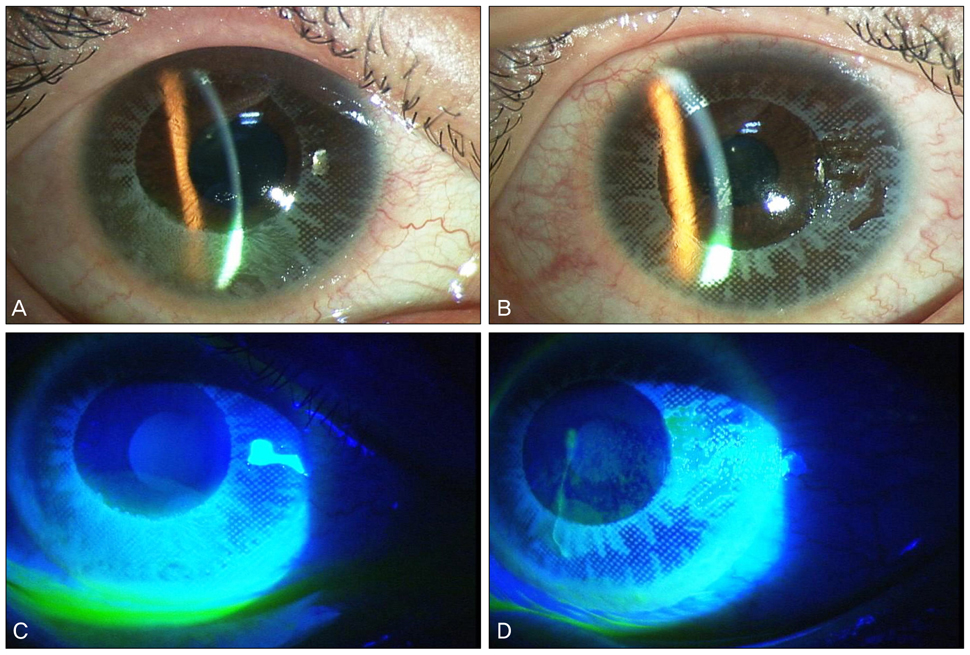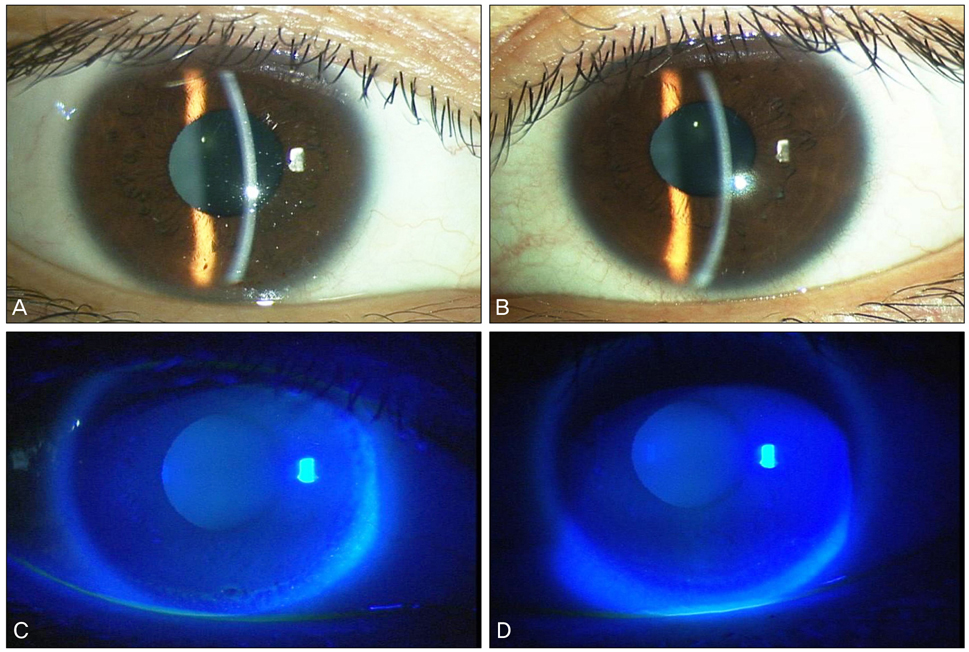Korean J Ophthalmol.
2010 Dec;24(6):367-370. 10.3341/kjo.2010.24.6.367.
Pigment Deposition of Cosmetic Contact Lenses on the Cornea after Intense Pulsed-Light Treatment
- Affiliations
-
- 1HanGil Eye Hospital, Incheon, Korea. limthnet@naver.com
- KMID: 1769092
- DOI: http://doi.org/10.3341/kjo.2010.24.6.367
Abstract
- We report a case of corneal deposition of pigments from cosmetic contact lenses after intense pulsed-light (IPL) therapy. A 30-year-old female visited our outpatient clinic with ocular pain and epiphora in both eyes; these symptoms developed soon after she had undergone facial IPL treatment. She was wearing cosmetic contact lenses throughout the IPL procedure. At presentation, her uncorrected visual acuity was 2/20 in both eyes, and the slit-lamp examination revealed deposition of the color pigment of the cosmetic contact lens onto the corneal epithelium. We scraped the corneal epithelium along with the deposited pigments using a no. 15 blade; seven days after the procedure, the corneal epithelium had healed without any complications. This case highlights the importance of considering the possibility of ocular complications during IPL treatment, particularly in individuals using contact lenses. To prevent ocular damage, IPL procedures should be performed only after removing the lenses and applying eyeshields.
MeSH Terms
Figure
Reference
-
1. Phillips AJ, Speedwell L, editors. Contact lenses. 2007. 5th ed. London: Butterworth Heinemann;519–530.2. Lim TH, Lee JR, Choi KY, et al. Corneal melting and descemetocele resulting from noninfectious keratitis related to the cosmetic contact lenses. J Korean Ophthalmol Soc. 2009. 50:774–778.3. Steinemann TL, Pinninti U, Szczotka LB, et al. Ocular complications associated with the use of cosmetic contact lenses from unlicensed vendors. Eye Contact Lens. 2003. 29:196–200.4. Steinemann TL, Fletcher M, Bonny AE, et al. Over-the-counter decorative contact lenses: cosmetic or medical devices? A case series. Eye Contact Lens. 2005. 31:194–200.5. Raulin C, Greve B, Grema H. IPL technology: a review. Lasers Surg Med. 2003. 32:78–87.6. Goldberg DJ, Cutler KB. Nonablative treatment of rhytids with intense pulsed light. Lasers Surg Med. 2000. 26:196–200.7. Bitter PH. Noninvasive rejuvenation of photodamaged skin using serial, full-face intense pulsed light treatments. Dermatol Surg. 2000. 26:835–842.8. Gagnon MR, Walter KA. A case of acanthamoeba keratitis as a result of a cosmetic contact lens. Eye Contact Lens. 2006. 32:37–38.9. Carkeet A. Field restriction and vignetting in contact lenses with opaque peripheries. Clin Exp Optom. 1998. 81:151–158.10. Hiraoka T, Ishii Y, Okamoto F, Oshika T. Influence of cosmetically tinted soft contact lenses on higher-order wavefront aberrations and visual performance. Graefes Arch Clin Exp Ophthalmol. 2009. 247:225–233.11. Choi HW, Moon SW, Nam KH, Chung SH. Late-onset interface inflammation associated with wearing cosmetic lenses 18 months after laser in situ keratomileusis. Cornea. 2008. 27:252–254.
- Full Text Links
- Actions
-
Cited
- CITED
-
- Close
- Share
- Similar articles
-
- Characteristics and Complications of Cosmetic Contact Lens
- Corneal Melting and Descemetocele Resulting From Noninfectious Keratitis Related to the Cosmetic Contact Lenses
- Two Cases of Poikiloderma of Neck and Chest Treated by Intense Pulsed Light
- Physiological Changes in the Cornea When Wearing Rigid Gas Permeable Contact Lenses
- Characteristics of Scleral Lenses and Patient Selection




